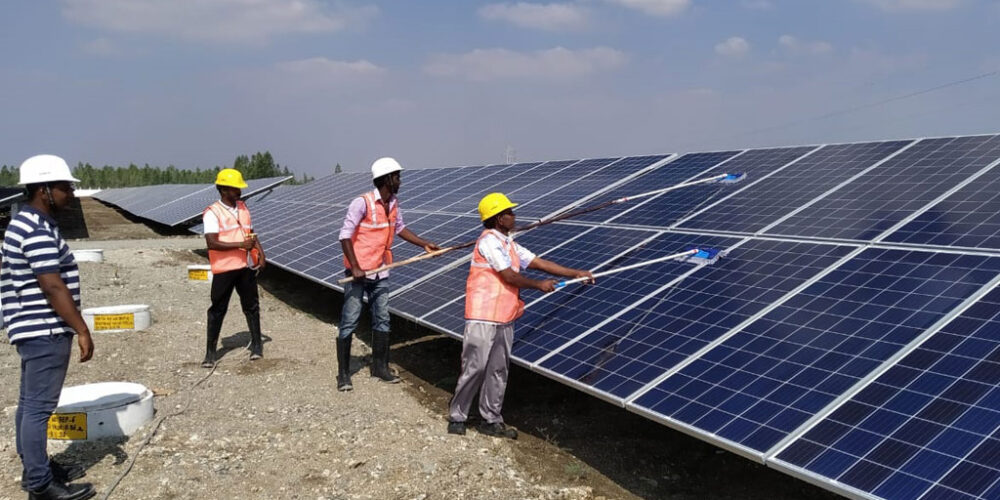
Key Challenges in the Growth of Solar PV Technology in India
With an aim to help the country meet its ambitious renewable energy targets, Acerenew is continuously working on developing and deploying the latest solar technology. Here, we’ll dig into India’s critical challenges in solar growth and how the Solar Industry Company India is embracing new innovations to boost power generation and efficiency.
What is India’s solar energy potential?
According to REN21, Renewables 2024 Global Status Report, India stands 4th globally in Renewable Energy Installed Capacity (including Large Hydro), 4th in Wind Power capacity & 5th in Solar Power capacity. India aims at expanding its solar capacity to 500 GW by 2030. Some of the key aspects of India’s solar potential:
- The Government has approved 45 solar parks with an aggregate capacity of 37 GW.
- The top 7GW capacity solar parks in India include Pavagada (2 GW), Kurnool (1 GW), and Bhadla-II (648 MW).
- India will soon be home to the world’s largest renewable energy park of 30 GW capacity in Gujarat.
- High-efficiency solar PV Modules have been included in the Production-Linked Incentive (PLI) Scheme to improve India’s manufacturing capabilities and enhance exports.
As a leading solar engineering company, we are dedicated to fuelling India’s renewable energy goals by contributing to a sustainable future. We aim to promote decentralized energy access while working on advancing solar technology. Next, we will learn more about the latest solar technologies in India that are reshaping the country’s future.
Solar Technologies in India
The best solar industry company in India, like us, is adapting to new technology and innovations to bring the best to you.
Integration of AI
AI-integrated solar panels can analyze environmental data and weather patterns to determine the optimal positioning of the panels. They can also detect and diagnose issues with solar panels quickly, allowing for faster and more effective maintenance. In addition, they dynamically adjust panel angles throughout the day to receive the maximum amount of sunlight.
Solar Photovoltaic (PV) Technology
The latest advancements in Solar PV Energy Solutions have increased panel efficiency from 20% to 25%. PV technology like bifacial and monocrystalline panels increases energy generation compared to traditional monofacial panels. As the name suggests, the panel can absorb sunlight on both faces in bifacial panels. Bifacial module manufacturers claim up to a 30% increase in energy production production just from the extra power generated from the rear. They offer superior energy production with better low-light performance and lower temperature coefficient.
Monocrystalline panels are made from a single piece of silicon, allowing easy flow of electricity. Their pyramid cell pattern enables them to absorb more energy from the sun’s rays, offering higher efficiency.
Solar Thermal Technology
Solar thermal technology accumulates and concentrates sunlight through lenses to produce the high temperatures needed to generate electricity. Unlike traditional panels, they convert sunlight into heat and use it as electricity for residential purposes.
Challenges for solar industry in India
Delving into a few of the key challenges faced by solar industry:
Power Evacuation and Grid Stability
Grid stability and system strength have become crucial challenges for the Indian solar industry. A smoothly working grid and transmission lines is the key to making solar power work smoothly. The grid must stay stable, maintain high quality, and be able to handle power from solar plants.
Land acquisition issues
The country’s complex land acquisition rules and processes raise land purchase issues for solar plants. Moreover, it also affects the ecological balance and gives rise to land conflicts.
Operational challenges
Supply chain discrepancies and operational hindrances slow down the completion of solar projects. The Leading solar engineering company must plan meticulously to smoothen the logistics and operational glitches.
Financing complexities
The high initial cost of panels is a major challenge for homeowners switching to solar panels. In addition, the lack of low-interest solar loans or good credit offers slows solar growth.
Solar policy framework challenges
The lack of clarity in policies and regulations creates unwanted delays in the project. Without policy clarity, it becomes hard for investors, developers, and financiers to align on one single goal.
As one of India’s largest Solar PV Energy Solution providers, we promise to bring cutting-edge technologies and best practices to the country to help it remain competitive in the global solar market. Join us in creating a sustainable tomorrow with nature’s biggest reliable power source.

